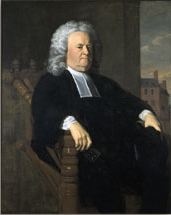Dr. Edward A. Holyoke
- Home
- About Salem »
- Salem Tales »
- Dr. Edward A. Holyoke
Edward Augustus Holyoke
1728 – 1829, Physician and Scientist
On Aug. 21, 1828, many of Salem’s most important citizens gathered at the Essex House to pay tribute to one of the town’s most beloved citizens, Dr. Edward Augustus Holyoke on the occasion of his 100th birthday. The highlight of the event was a toast offered by the honoree to his beloved Massachusetts Medical Society.
Holyoke was born in Marblehead, the son of the Rev. Edward Holyoke and Margaret Appleton of Ipswich. In 1737 his father was appointed president of Harvard and the family moved to Cambridge. The younger Edward entered the college at the age of 14 and graduated in the class of 1746.
After a brief stint as a teacher in Lexington and Roxbury, Holyoke moved to his mother’s hometown of Ipswich to study medicine under the esteemed physician, Col. Thomas Perry. When his two-year apprenticeship ended in 1749, Holyoke settled in Salem and opened a practice.
After a shaky start – he replaced a physician who was beloved by the local populace – the young doctor began attracting patients locally and in communities as far away as Methuen and Cape Ann. Traveling by horseback, chaise, or on foot, Holyoke over the next 80 years would cover an estimated one-and-a-half-million miles and make approximately a quarter-of-a-million house calls. During his career, 35 aspiring physicians would apprentice under the respected Salem doctor.

Edward Holyoke, 1759-61, by John Singleton Copley, oil on canvas 50 1/2 x 40 1/2in. (128.5 x 102.8 cm), Harvard University Portrait Collection
Throughout his long and successful career, Holyoke remained dedicated to the study of medicine and new medical treatments. For 75 years he kept daily weather records in the hopes of finding scientific connections between local atmospheric conditions and specific diseases. This venture proved unsuccessful, but he made many other contributions to the field of medicine. Holyoke, for example, was one of the first to make the connection between the use of pewter dishes and lead poisoning.
Holyoke’s open-mindedness made him a pioneer in the treatment and prevention of smallpox. When an epidemic of this deadly disease hit the Salem area in 1777, Holyoke, after first making out his will, allowed himself to be inoculated by Dr. Nathaniel Perkins in Boston.
He survived the highly controversial treatment, and subsequently convinced more than 600 of his own patients to let him innoculate them. Only two died, and the success of this treatment made Holyoke an early adherent of smallpox vaccination in later years.
Tragically, all of Holyoke’s expertise and experience often failed him when it came to treating his own family. His first wife, Judith Pickman, died in childbirth. And of the 12 children Edward had with Mary Vial, only four survived infancy.
His political leanings caused additional problems for Holyoke’s family during the Revolutionary War era. An avowed Loyalist who had the nerve to socialize with the hated Royal Governor, Thomas Hutchinson, Holyoke lost much of his standing in heavily patriotic Salem. While he chose to stay and care for his patients throughout the war, the physician wisely sent his family to live in Nova Scotia until it ended in 1783.
During the course of the conflict Holyoke came to believe in the patriotic cause and was singled out for many honors. In 1781, he was tapped by the Legislature to organize the Massachusetts Medical Society. He served for a time as the organization’s president and was a frequent contributor to its publication, now the New England Journal of Medicine. In 1783 he was awarded the first M.D. degree ever given by the Harvard Medical School.
Holyoke’s interests were not limited to science and medicine. He was a founder of both the Social and Philosphical libraries in Salem, and was a driving force in the merger of these two institutions into the Salem Athenaeum in 1810. He was also an incorporator of the Essex Historical Society, later the Essex Institute, in 1821.
When the American Academy of Arts and Sciences was formed in 1790 for the encouragement and dissemination of knowledge, Holyoke joined the likes of George Washington and Benjamin Franklin as a charter member. He later served as the academy’s president for six years.
Holyoke, a near vegetarian who liked his liquor and tobacco, died in 1829. He left behind 122 daybooks relating to his medical practice and a 120-volume diary.
Jim McAllister
All rights reserved

